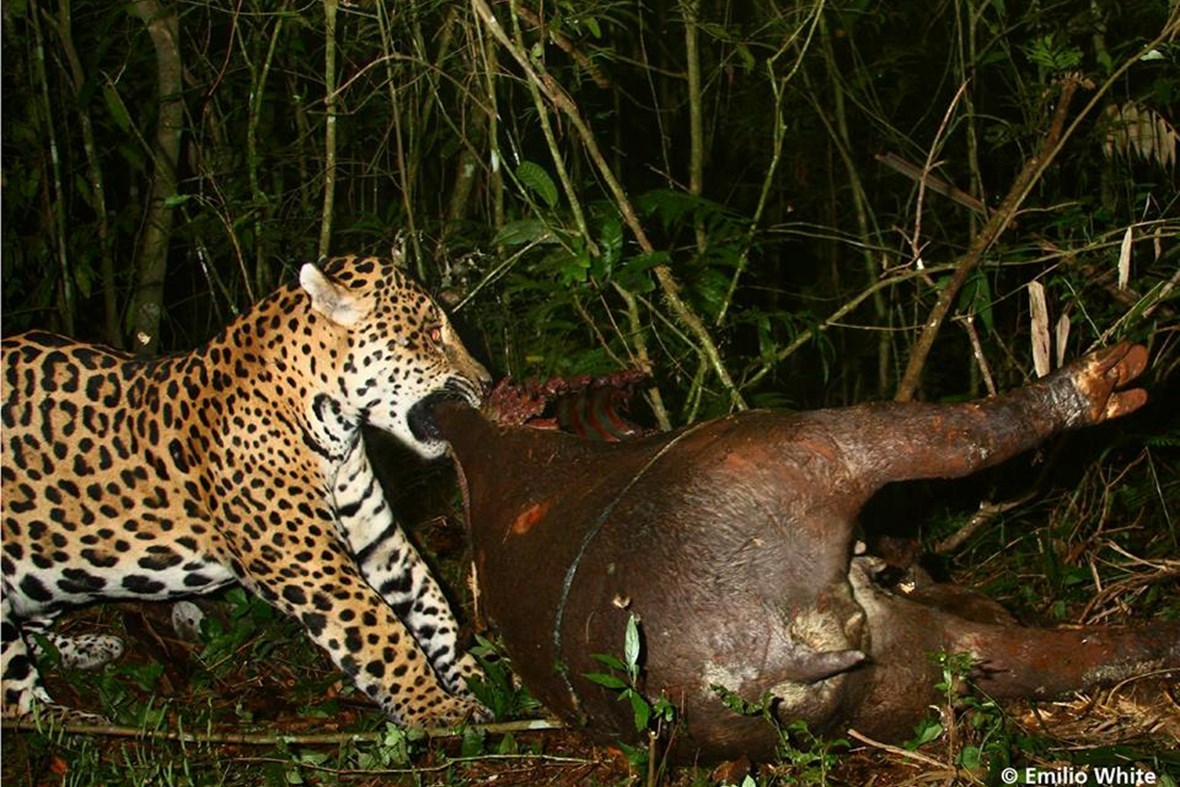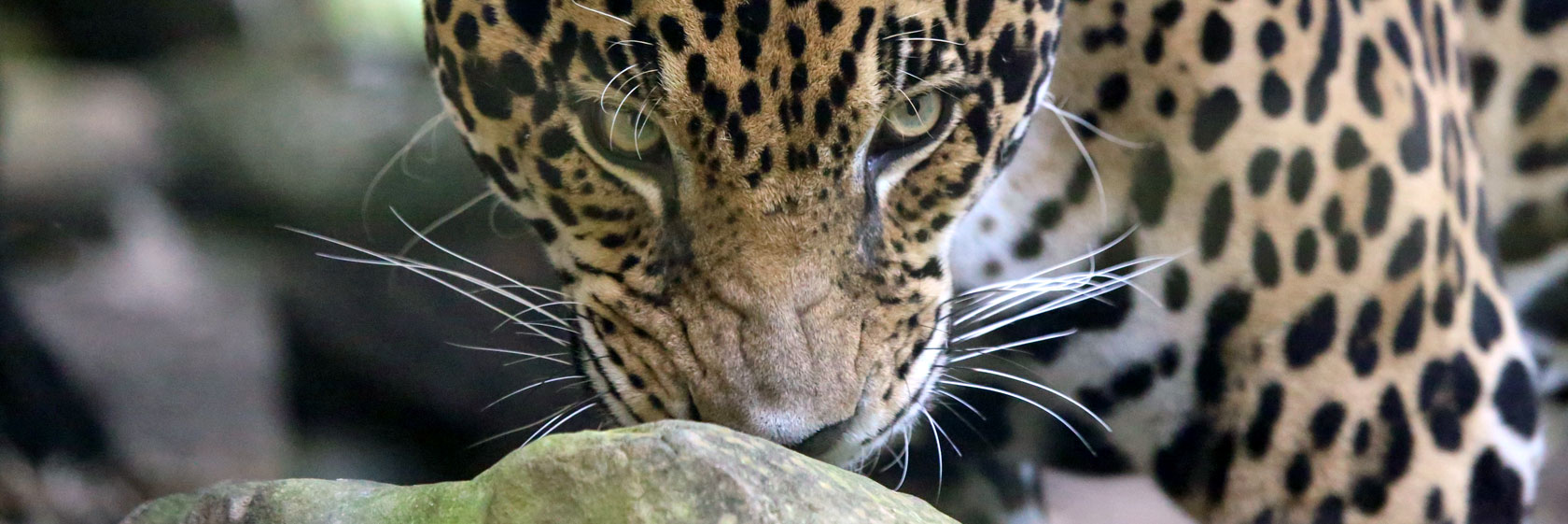By Ethan Shaw October 19 2016
A male jaguar called El Jefe ("The Boss") has been in the news a lot lately. He's the only known wild representative of his kind in the United States, and his turf – the Santa Rita Mountains of southeastern Arizona – is being considered for a hugely contentious open-pit copper mine.
And according to a recent Smithsonian Magazine profile, America's celebrity jaguar is also a bear killer.

While shadowing El Jefe in the Santa Rita backcountry, biologist Chris Bugbee discovered the strewn bones of a black bear, including a crushed, tooth-punctured skull (photographer Bill Hatcher was able to capture several snapshots of the remains). Assisting with the El Jefe-tracking task was Bugbee's dog Mayke, a Belgian Malinois specially trained to sniff out jaguar and ocelot poop.
Back at the lab, analysis later confirmed that jaguar scat collected at the scene contained bear hairs. According to Bugbee's colleague (and wife) Aletris Neils, with whom he runs the nonprofit Conservation CATalyst, the bear skeleton likely belonged to a young adult sow.
The unusual find, Bugbee suggests, marks the first known instance of a jaguar preying on a black bear. Such an event could only occur in the American Southwest or northern Mexico, where the stomping grounds of the mainly temperate black bear and the mainly tropical/subtropical jaguar overlap. "It was north against south, and south won," Neils tells Smithsonian.
As El Jefe's bear lunch suggests, jaguars are opportunistic hunters. They often actively prowl in search of prey, then attempt to stalk and kill any they encounter. More comfortable getting their paws wet than most felines, they'll also cruise riverbanks and wetland fringes questing for huge capybaras, as well as caimans, which can make up nearly 50 percent of jaguar diets in water-logged habitats. And as this footage plainly shows, the bigs cats are not afraid to pounce on full-sized caimans in their watery element, showing some mind-boggling strength hauling the reptiles ashore.
That same muscle power and ease in the water come in handy when hunting supersized rodents – just watch this Brazilian jaguar in full submarine mode as it wrestles a capybara from the depths.
And according to a recent Smithsonian Magazine profile, America's celebrity jaguar is also a bear killer.

El Jefe, the only known wild jaguar in the United States, wandering the Santa Rita Mountains. Image: Conservation CATalyst
While shadowing El Jefe in the Santa Rita backcountry, biologist Chris Bugbee discovered the strewn bones of a black bear, including a crushed, tooth-punctured skull (photographer Bill Hatcher was able to capture several snapshots of the remains). Assisting with the El Jefe-tracking task was Bugbee's dog Mayke, a Belgian Malinois specially trained to sniff out jaguar and ocelot poop.
Back at the lab, analysis later confirmed that jaguar scat collected at the scene contained bear hairs. According to Bugbee's colleague (and wife) Aletris Neils, with whom he runs the nonprofit Conservation CATalyst, the bear skeleton likely belonged to a young adult sow.
The unusual find, Bugbee suggests, marks the first known instance of a jaguar preying on a black bear. Such an event could only occur in the American Southwest or northern Mexico, where the stomping grounds of the mainly temperate black bear and the mainly tropical/subtropical jaguar overlap. "It was north against south, and south won," Neils tells Smithsonian.
As El Jefe's bear lunch suggests, jaguars are opportunistic hunters. They often actively prowl in search of prey, then attempt to stalk and kill any they encounter. More comfortable getting their paws wet than most felines, they'll also cruise riverbanks and wetland fringes questing for huge capybaras, as well as caimans, which can make up nearly 50 percent of jaguar diets in water-logged habitats. And as this footage plainly shows, the bigs cats are not afraid to pounce on full-sized caimans in their watery element, showing some mind-boggling strength hauling the reptiles ashore.
That same muscle power and ease in the water come in handy when hunting supersized rodents – just watch this Brazilian jaguar in full submarine mode as it wrestles a capybara from the depths.
In the Smithsonian article, Bugbee speculates El Jefe could have taken down the black bear by ambushing the unsuspecting animal as it foraged. The bear's mangled skull fits a distinctive pattern of jaguar kills: the big cats commonly dispatch capybaras by puncturing their braincase, a feat that requires precise fang placement and massive crushing power. (Jaguars have proportionately the strongest bite of any big cat, which also serves them well when munching turtles.)
Interestingly, some evidence suggests that spectacled bears, the only South American representatives of the bear family, avoid jaguars where the two share habitat.
More than a hundred species have been recorded as jaguar fodder across the cats' range, although recent research suggests they especially favour capybara, caiman, collared peccaries (or javelina), nine-banded armadillos, wild pigs, white-nosed coatis and giant anteaters (though as we saw just last month, giant anteaters aren't pushovers when it comes to jaguars). The study, nicely summarised here, speculated that jaguars might have escaped the great megafaunal extinctions at the end of the last ice age in the Americas by adapting to smaller prey, and consequently diminishing in size themselves.
Jaguars only rarely tackle adult South American tapirs, the biggest terrestrial mammals in the Neotropics, although a beefy male named Aratiri in the Argentine Atlantic Forest is an accomplished tapir-hunter.

El Jefe's bear lunch sheds a little light on the "phantom ecology" of jaguars in the American Southwest, which were mostly shot and poisoned out by the mid-twentieth century. Since the cats weren't well studied before effectively disappearing, we don't know much about their food preferences.
The predators once flourished alongside grizzlies and Mexican wolves in the isolated mountain ranges of Arizona and New Mexico, along the Mogollon Rim, and occasionally beyond: as far north as the South Rim of the Grand Canyon, and eastward into South Texas thornscrub (and maybe even the swampy Texas-Louisiana border). Today, the nearest population of breeding jaguars to the US border exists in eastern Sonora.
El Jefe, who first came on biologists' radar in 2011, is only the latest of a string of male jaguars – known to be impressive wanderers – to reclaim southern Arizona territory over the past couple of decades. (His most famous predecessor was Macho B, a longtime resident of the state's Tumacacori Highlands until he was controversially euthanised in 2009.)
Interestingly, some evidence suggests that spectacled bears, the only South American representatives of the bear family, avoid jaguars where the two share habitat.
More than a hundred species have been recorded as jaguar fodder across the cats' range, although recent research suggests they especially favour capybara, caiman, collared peccaries (or javelina), nine-banded armadillos, wild pigs, white-nosed coatis and giant anteaters (though as we saw just last month, giant anteaters aren't pushovers when it comes to jaguars). The study, nicely summarised here, speculated that jaguars might have escaped the great megafaunal extinctions at the end of the last ice age in the Americas by adapting to smaller prey, and consequently diminishing in size themselves.
Jaguars only rarely tackle adult South American tapirs, the biggest terrestrial mammals in the Neotropics, although a beefy male named Aratiri in the Argentine Atlantic Forest is an accomplished tapir-hunter.

Aratirí, seen here with a tapir carcass, is one of the largest jaguars known to inhabit the Atlantic Forest, which spans parts of Brazil, Paraguay and Argentina. Image: Emilio White/Proyecto Yaguarte
El Jefe's bear lunch sheds a little light on the "phantom ecology" of jaguars in the American Southwest, which were mostly shot and poisoned out by the mid-twentieth century. Since the cats weren't well studied before effectively disappearing, we don't know much about their food preferences.
The predators once flourished alongside grizzlies and Mexican wolves in the isolated mountain ranges of Arizona and New Mexico, along the Mogollon Rim, and occasionally beyond: as far north as the South Rim of the Grand Canyon, and eastward into South Texas thornscrub (and maybe even the swampy Texas-Louisiana border). Today, the nearest population of breeding jaguars to the US border exists in eastern Sonora.
El Jefe, who first came on biologists' radar in 2011, is only the latest of a string of male jaguars – known to be impressive wanderers – to reclaim southern Arizona territory over the past couple of decades. (His most famous predecessor was Macho B, a longtime resident of the state's Tumacacori Highlands until he was controversially euthanised in 2009.)
To encourage more of the great spotted cats to repopulate borderland habitat, conservationists hope to establish protected corridors between the Sonoran jaguar population (which finds refuge in the remote Northern Jaguar Reserve) and the US line – but obstacles such as the proposed copper mine, not to mention Donald Trump's visions of "an impenetrable and beautiful wall", threaten to stand in the jaguars' way.
__
Top header image: cuatrok77, Flickr

No comments:
Post a Comment